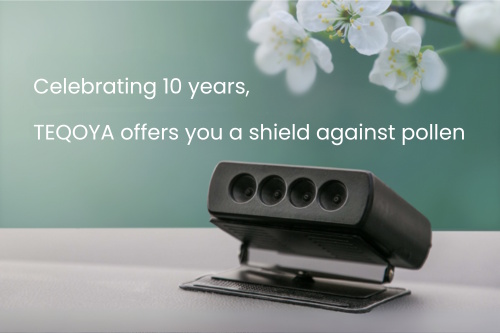Air purifier, humidifier and dehumidifier: what are the differences?
Air purifiers, humidifiers, ionisers and dehumidifiers can have an impact on the air you breathe in your home. However, they each have a different purpose with unique benefits. If you're looking for ways to relieve allergies, improve dry air conditions, or create a healthy environment for your child, you need to understand the differences between these devices. We explain how each device works and the best ways to use them safely.
Why use a humidifier?
Air that is too dry can put a lot of strain on your home (increased dust, development of viruses and bacteria, cracks in furniture and parquet flooring). Also on your health (headaches, dry throat, rhinitis, eye irritation, dry skin and mucous membranes).

An appropriate level of humidity helps to breathe well:
The Agence de la transition écologique (ADEME) recommends keeping the air in your home between 40 and 60% humidity. Research conducted by the National Institute for Occupational Safety Health have shown that a humidity level of 40% or more reduces flu virus infectivity levels to about 14%. This helps explain why the dry winter climate makes us more vulnerable to disease. On the other hand, higher humidity can help to decongest the body: dry air can cause mucus to dry out and thicken. This can lead to nasal congestion, sore throats and sinus pain. Humidifiers, by adding moisture to the affected area, help to break down this mucus.
Why use an air dehumidifier?
High humidity, whether due to poor air circulation or poor ventilation, can lead to mold infestation and even exacerbate health problems such as allergies and asthma. A dehumidifier is an important tool to prevent moisture-related problems and improve the quality of your air. Like a humidifier, a dehumidifier can be especially useful in the bathroom or areas of your home where humidity is often excessive.
Getting rid of dust mites
Dust mites are a common trigger for allergies and asthma. For people with asthma, high humidity can create a cycle of breathing difficulties, excessive sweating and dehydration. A medical journal study on allergies found that homes maintaining humidity levels below 51% had a significant reduction in the number of dust mites.
Reduce mold growth
Mould grows in areas of your home that are too damp. The National Institutes of Health (NIH) reports that in people with sensitive airways, allergy and asthma symptoms can be triggered by inhaling mould spores (particles emitted by the mould that allow them to grow). The NIH also suggests using an air dehumidifier to control exposure to allergy triggers.
Why use an air purifier, ionizer type?
Air purifiers have the function of purifying the air. Air pollution is known to aggravate or trigger respiratory allergies and asthma attacks. Conventional air purifiers are based on an air filtration system, containing disposable filters. Depending on the type of device and the filters that make it up, maintenance of this type of air purifier is a delicate and essential operation. We invite you to read our article on the subject.
Unlike filter air purifiers, the TEQOYA ioniser air purifier does not require filters and does not produce draughts. The TEQOYA air ioniser produces a large quantity of negative ions, which charge the airborne pollutants, thus making them fall to the ground. Easy to use and totally silent, TEQOYA air purifiers reproduce a natural depollution process : air ionisation.
Fight against allergens (dust mites, pollens, moulds) and bio-contaminants (viruses and bacteria).
Some air purifiers are designed to reduce airborne allergens such as dust mites, pet dander, pollen or mould spores. Many people with allergies or asthma use an air purifier to reduce their exposure to these triggers.
TEQOYA air ionisers work effectively to reduce particles and allergens (known asthma triggers) in the air. They neutralise up to 99% of the ultra-fine particles and germs that irritate the respiratory tract and weaken the immune system. To find out more about the effectiveness of TEQOYA air purifiers on viruses, including COVID, read our detailed article on the subject.

A purifier (or ioniser), a dehumidifier and a humidifier perform different functions. A purifier can be used in addition to a humidifier or dehumidifier, possibly in the same room. However, if you use a filtered air purifier, you should avoid placing it in the same room as a humidifier, as the humidity in the air could clog the filters and encourage the growth of mould and bacteria.
Information on air quality and news from TEQOYA
How does an air ionizer work?
#Essential
Natural environments are rich in negative ions. This is precisely the principle on which the air ionizer is based on. However, do you know how this technology manages to capture the pollution particles contained in the indoor air to purify your home?
Are air purifiers effective against viruses, especially the coronavirus COVID-19
#Virus and microorganismes #L'essentiel
In December 2019, a respiratory virus of the Coronavirus family appeared in the Wuhan region of China and has now spread to all continents.
What is eco-responsibility?
#Essential
Purifying indoor air while protecting your health and the planet is possible! Say goodbye to filters and make way for negative ions: choose an eco-responsible air purifier that will easily reduce energy and resource consumption.

